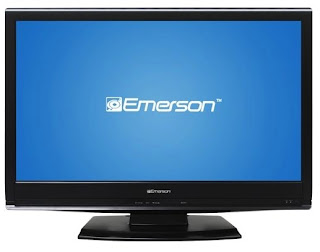Walmart on Black Friday. Despite all of these things, I got talked into going to Walmart on Black Friday in 2010. Until a recent mishap, I was actually glad I did it. I purchased a 42" Emerson 1080p LCD HDTV for next to nothing and was quite happy with it.
AND THEN...
 Just after the warranty expired, like magic, the TV started having problems. BIG PROBLEMS. Well, they started small but grew like weeds. It all started in the middle of Dora The Explorer. I went to turn the volume down with the remote and there was no response. I assumed it was the batteries, so naturally, I left my seat and pushed the power button on my Emerson TV. No response. What did I do? I unplugged the damn thing, plugged it back in and pushed power. The blue light came on at the bottom left of the TV. That was it. It still wouldn't turn on. I temporarily gave up.
Just after the warranty expired, like magic, the TV started having problems. BIG PROBLEMS. Well, they started small but grew like weeds. It all started in the middle of Dora The Explorer. I went to turn the volume down with the remote and there was no response. I assumed it was the batteries, so naturally, I left my seat and pushed the power button on my Emerson TV. No response. What did I do? I unplugged the damn thing, plugged it back in and pushed power. The blue light came on at the bottom left of the TV. That was it. It still wouldn't turn on. I temporarily gave up.A few hours later, I decided to do what most people do when they can't figure something out. www.google.com. Lo and behold, I see hundreds of people with the same problem. I see hundreds of people that are disgusted with Emerson and Walmart. I see hundreds of people that seem to be SOL and reverting back to their old tube TV's. I don't see any answers.
For a while I contemplated making a video pretending to play Wii bowling and launching my WiiMote into an already broken TV. I figured I could at least get some YouTube hits out of this. Fortunately, I refrained.
Now, being a computer guy, this idea popped into my head. For computers, I consider it one of the oldest tricks in the book. It's typically the computer world's equivalent to raising Lazarus from the dead. Folks, behold the power drain! I'm not going to get into the science of it but I will tell you how it's done.
Here's how you do it:
1. Unplug the TV from the outlet
2. Hold the power button down for at least 1 minute.
3. Plug the TV back in.
4. Push the power button.
After I did this, to my surprise, the TV came on like normal. I cheered wildly and knocked on some wood. Now, the next day it happened again. So I drained the power again, thinking this was going to become the standard power on procedure. Well, that was the last time I had to do it. It's been almost 3 weeks now and the TV is working perfectly! Maybe what I did didn't actually fix it. Maybe it's just some giant coincidence. I don't care. It works, and I didn't spend a dime.
If this helps just one person, I'll be thrilled. Try it out and let me know how it goes!











































